Introduction
In the realm of data-driven decision-making, the ability to access timely and accurate information is paramount. Power BI’s auto-refresh feature stands as a vital tool, empowering organizations to maintain the relevance of their reports while minimizing the burden of manual updates. By automating data refreshes, businesses not only enhance their operational efficiency but also ensure that stakeholders are equipped with the latest insights necessary for strategic planning.
This article delves into the importance and benefits of Power BI auto-refresh, offering a step-by-step guide for setup, exploring best practices for publishing reports, troubleshooting common issues, and examining advanced techniques that leverage APIs and integrations. Each section is designed to provide practical solutions that streamline workflows and drive informed decision-making, ultimately positioning organizations for success in a competitive landscape.
Understanding Power BI Auto-Refresh: Importance and Benefits
The power bi auto-refresh data and publish feature is essential for ensuring that reports remain both relevant and accurate. By automating information updates at designated intervals, organizations can guarantee that stakeholders have access to the latest details, which is vital for informed decision-making. This corresponds with the wider strategy of streamlining workflows through solutions such as Automate, which provides AI-driven automation to link applications and information, thus decreasing manual workloads and improving operational efficiency.
Power BI starts scheduled refreshes within 15 minutes of the planned time slot, but delays of up to one hour can happen, emphasizing the need for timely insights and efficient information management. Furthermore, it is crucial to recognize that a semantic model can only utilize a single gateway connection, necessitating all required source definitions to be added to that gateway. This technical constraint emphasizes the critical nature of managing information effectively, which can be further enhanced through Robotic Process Automation (RPA).
Statistics reveal that a significant number of refreshes—26% come in at 50%, and 58% under 25%—highlight the critical nature of accurate and timely information. Additionally, a case study named ‘High Processor Time Optimization’ demonstrates that high processor time may suggest costly transformations that are not being folded, resulting in prolonged update times. Employing query folding within the source can lessen the load on the flow compute engine, enhancing refresh performance.
This capability not only improves accuracy but also reduces the burden of manual updates, allowing teams to concentrate on strategic initiatives rather than administrative tasks. For companies that rely on dynamic information sources and need to monitor rapidly evolving metrics, recognizing the advantages of Power BI auto-refresh data and publish, along with the efficiency gains from RPA and Automate’s structured approach to automating processes, is a crucial step toward maximizing operational efficiency and ensuring high-quality reporting. We encourage you to book a free consultation to explore how we can help you implement these solutions effectively.
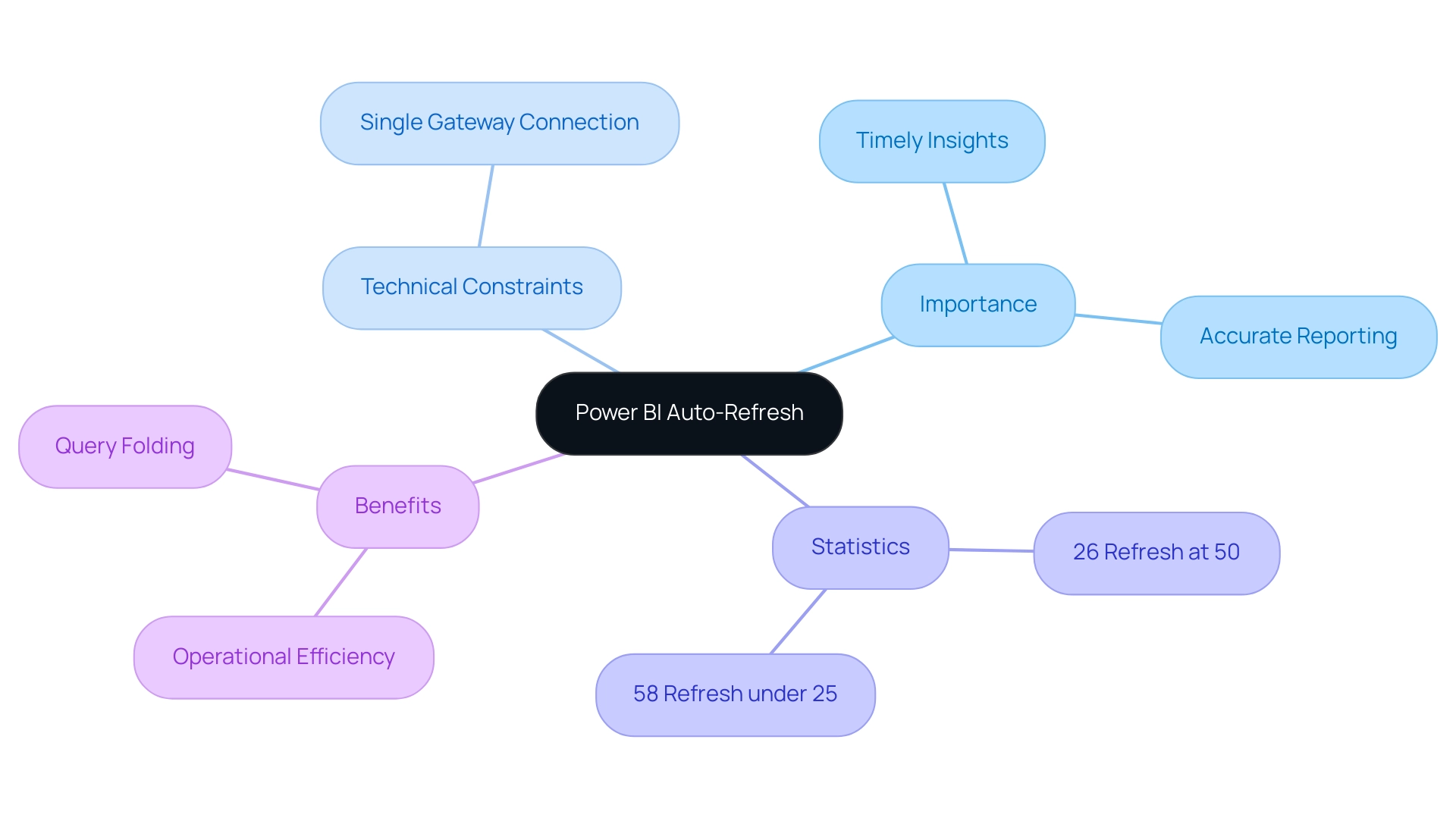
Step-by-Step Guide to Setting Up Auto-Refresh in Power BI
Configuring Power BI auto-refresh data and publish can greatly enhance your reporting process, ensuring your information is always up-to-date and actionable. In today’s data-rich environment, users often spend about 4 hours trying to set up BI, highlighting the need for an efficient auto-refresh configuration. Furthermore, incorporating RPA solutions can relieve time-consuming tasks and enhance operational efficiency by automating repetitive processes that lead to inconsistencies.
Follow this comprehensive guide to effectively configure Power BI auto-refresh data and publish:
- Launch BI Desktop: Start by opening the application and accessing your file.
- Navigate to Data Source Settings: Access this by clicking on ‘File’, then ‘Options and settings’, and finally ‘Data source settings’.
- Modify Data Source: Choose the data source intended for auto-refresh and click on ‘Change Source’. Ensure that your selected source supports auto-refresh capabilities.
- Power BI auto-refresh data and publish: Once you have finalized your document, you can select ‘Publish’ from the Home tab to upload it to the BI Service.
- Set Up Scheduled Refresh: In the Power BI Service, locate your dataset to set up power bi auto-refresh data and publish by selecting ‘Schedule Refresh’. This allows you to keep your online reports updated automatically.
As Alexis Olson observes, the scheduled update is particularly convenient as it allows power bi auto-refresh data and publish, updating the data stored online and eliminating the need to republish whenever changes are necessary, making it distinct from the manual update in the desktop app.
- Configure Update Settings: Determine the update frequency—whether daily or weekly—and select the appropriate time zone for your update cycle.
- Save Settings: Click ‘Apply’ to finalize your settings. Your report is now configured to power bi auto-refresh data and publish automatically based on the specifications you’ve established.
Additionally, consider upgrading to Premium Per User to enhance performance and eliminate potential timeout issues during update cycles. This upgrade not only improves functionality but also provides access to additional features that can further streamline your reporting process. Furthermore, it’s essential to monitor your updating processes.
For instance, BI sends notifications to the semantic model owner regarding refresh failures, ensuring timely responses to any issues that arise. By applying these strategies, you can ensure your data stays current effortlessly, driving informed decision-making that promotes business growth while tackling the challenges of content creation and data inconsistencies.
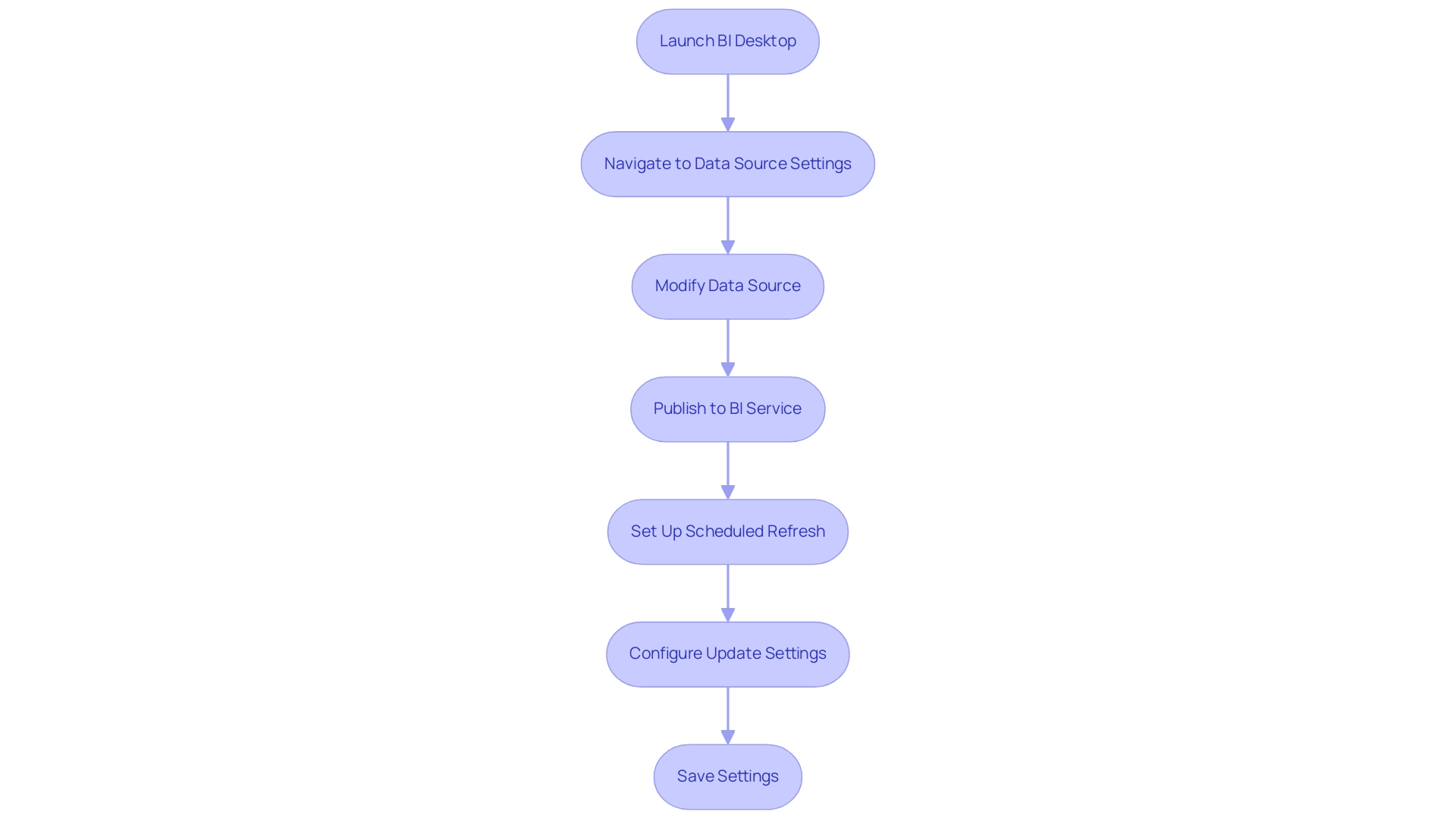
Publishing Power BI Reports: Options and Best Practices
When it comes to releasing BI visuals, there are several effective options to consider:
- Power BI Service: This is the most widely used method, allowing users to publish documents directly to the Power BI cloud service. This approach facilitates easy sharing and collaboration among team members. Notably, the usage metrics document only includes records or dashboards that have been accessed in the past 90 days, which is crucial for understanding visibility and usage trends, particularly in a data-rich environment where extracting actionable insights is key to maintaining a competitive edge.
- Embedding in SharePoint or Teams: Reports can be seamlessly integrated into SharePoint sites or Microsoft Teams, enhancing accessibility for all team members. As Maggie from Community Support points out, your users require a pro account to access data embedded in SharePoint. If you possess a premium license, you can place the content of the documents under this capacity, enabling users with free accounts to access them. This method not only enhances collaboration but also tackles challenges related to accessibility.
- Publish to Web: This option allows the creation of a public link to your document, although caution is advised as it may potentially expose sensitive data.
- Export to PDF or PowerPoint: For static documentation needs, exporting documents to PDF or PowerPoint can be an effective solution.
Best Practices: Ensure that all shared data aligns with your organization’s data governance policies. Regular updates to documents are crucial for reflecting the latest insights. Additionally, employing descriptive titles and tags will significantly enhance the discoverability of your documents.
Furthermore, understanding document usage—such as contributions to individual counts, open percentages, and viewing trends—can inform your publishing strategies. For instance, a recent case study highlighted how a user sought clarification on retrieving more than 5000 audit log results, indicating the need for automation in reporting. Tools like EMMA RPA and Automate can streamline this process, automating repetitive tasks and enhancing operational efficiency.
By following these strategies, you can maximize the impact and accessibility of your BI reports within your organization, ultimately driving growth and innovation through effective data utilization. Failing to leverage these insights can leave your business at a competitive disadvantage, underscoring the importance of integrating automation solutions.
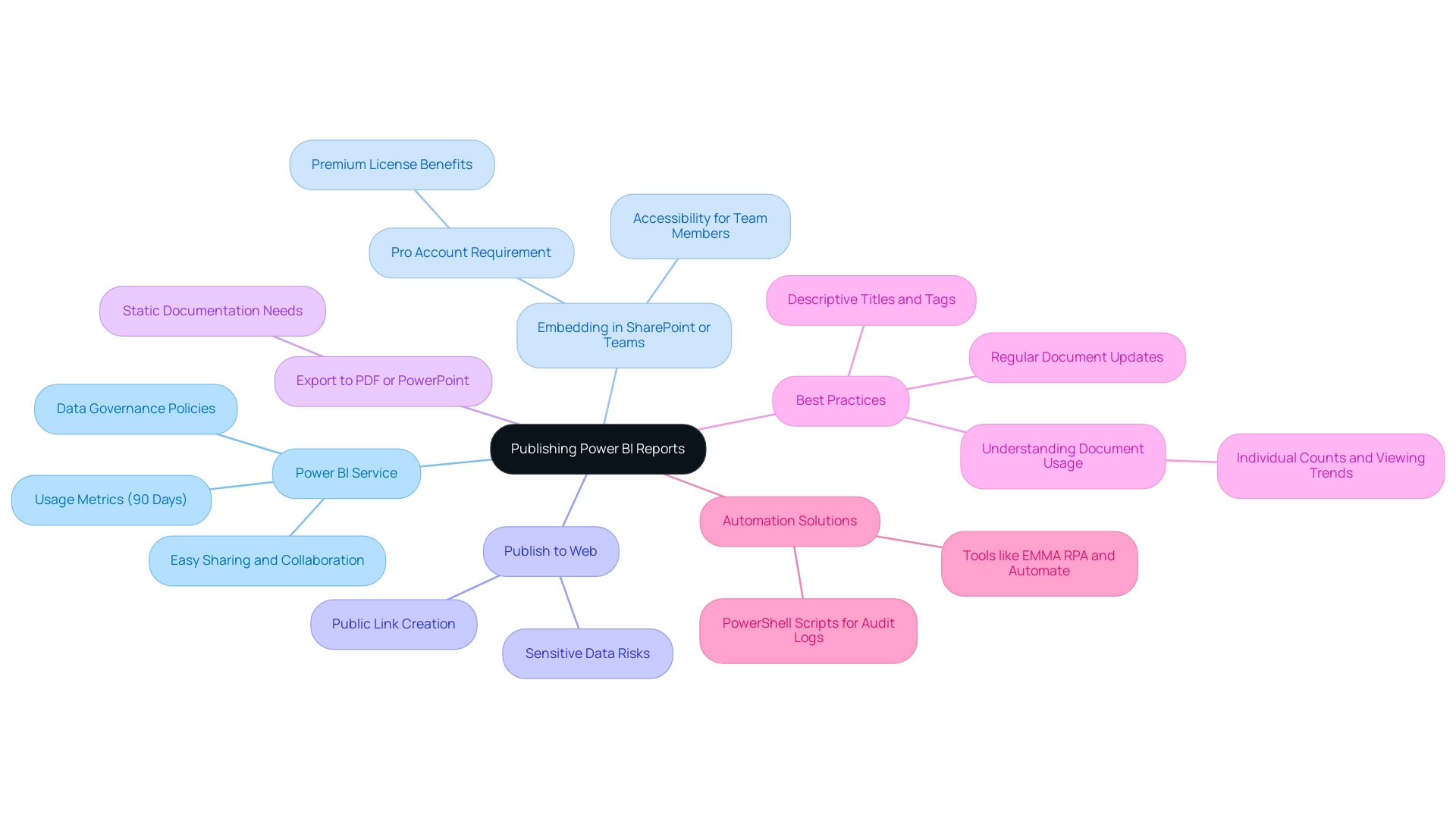
Troubleshooting Auto-Refresh: Common Issues and Solutions
Setting up power bi auto-refresh data and publish can present various challenges that need to be addressed to ensure a seamless experience. Here are some common issues users may face along with their solutions:
-
Data Source Credentials: Incorrectly configured credentials can result in update failures.
Always verify that your information source credentials are valid and up to date. -
Scheduled Update Limitations: Comprehend the update frequency constraints set by the Power BI Service, as these can determine how often your information gets updated.
It’s crucial to recognize that following an update, there may be a wait period of 10-15 minutes for the revised information to be shown in the dashboard tiles. -
Information Structure Mistakes: An imperfect information model can stop the update process.
It’s crucial to validate your queries and ensure that your data transformations are error-free. Furthermore, be aware that BI Desktop cannot batch multiple table changes into a single transaction, which may complicate the update process. -
Network Issues: A stable internet connection is essential.
Connectivity disruptions can interfere with the refresh process, so check your network stability regularly.
Solutions:
To troubleshoot effectively, monitor the refresh history in Power BI Service for any error messages that may indicate the source of the problem. Review your information source settings meticulously and confirm that all required permissions are in place.
Engaging in regular monitoring and maintenance of these factors can significantly enhance the reliability of your power bi auto-refresh data and publish processes, thereby driving operational efficiency. Moreover, leveraging RPA can automate these troubleshooting processes, reducing manual effort and ensuring quicker resolutions.
Furthermore, as David Browne from Microsoft states,
Not all information sources require a gateway.
In general, Cloud Services like OneDrive and SharePoint Online don’t require a gateway, simplifying the setup for those platforms. Additionally, the analytics tool sends notifications to the semantic model owner regarding refresh failures, enabling timely responses to any issues.
By tackling these typical problems proactively and employing customized AI solutions to evaluate and enhance your information management strategies, you can guarantee a more efficient and dependable operation of Power BI auto-refresh data and publish, ultimately unlocking the potential of your insights to drive informed decision-making and business growth.
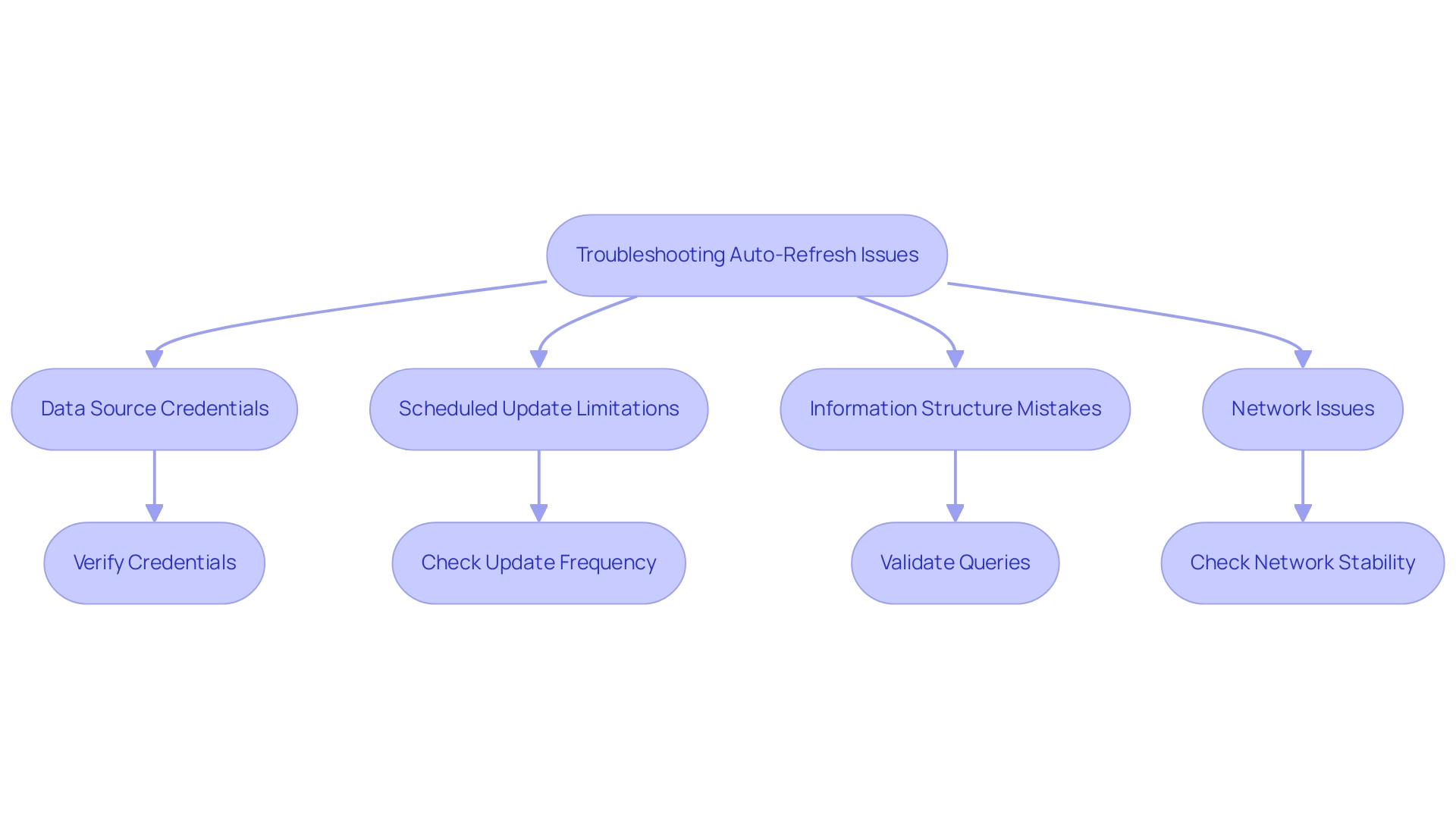
Advanced Techniques for Power BI Auto-Refresh: APIs and Integrations
For those aiming to elevate their BI auto-refresh capabilities, several advanced techniques can be instrumental:
-
Employing the BI REST API: This robust tool enables users to automate refreshes programmatically, providing enhanced control over refresh schedules and facilitating integration with other applications. By automating these processes through Robotic Process Automation (RPA), organizations can streamline their information management effectively. Notably, when a copy of the usage report is created, Power BI generates an editable report in the current workspace, which can be leveraged to access usage statistics through the REST API.
-
Integration with Azure Functions: By leveraging Azure Functions, businesses can trigger refreshes based on specific events or conditions, resulting in a more responsive and dynamic management approach. This strategy enhances efficiency and aligns seamlessly with RPA initiatives, ensuring that information reflects real-time changes.
-
Developing Custom Connectors: For unique information sources that Power BI does not natively support, creating custom connectors is essential. This capability promotes smooth information integration, ensuring that all pertinent information is accessible for analysis and reporting, further improving operational efficiency.
These advanced techniques equip organizations with the tools required to enhance their information updating processes, such as Power BI auto-refresh data and publish, while also reducing the waste of time and resources linked to manual, repetitive tasks. As emphasized by Karen, who mentioned her experience with dataset configurations and scheduling, tackling update challenges proactively can lead to improved data utilization. She emphasized the importance of understanding dataset settings, which aligns with the recommended techniques for improving refresh strategies.
Furthermore, as illustrated in the case study on viewing all workspace usage metrics, removing the default filter allows for a comprehensive overview of usage metrics across the entire workspace, facilitating better insights into overall engagement. By employing these strategies, powered by RPA, reports remain consistently up-to-date, aligning with evolving business needs and driving data-driven insights for growth in a rapidly evolving AI landscape.
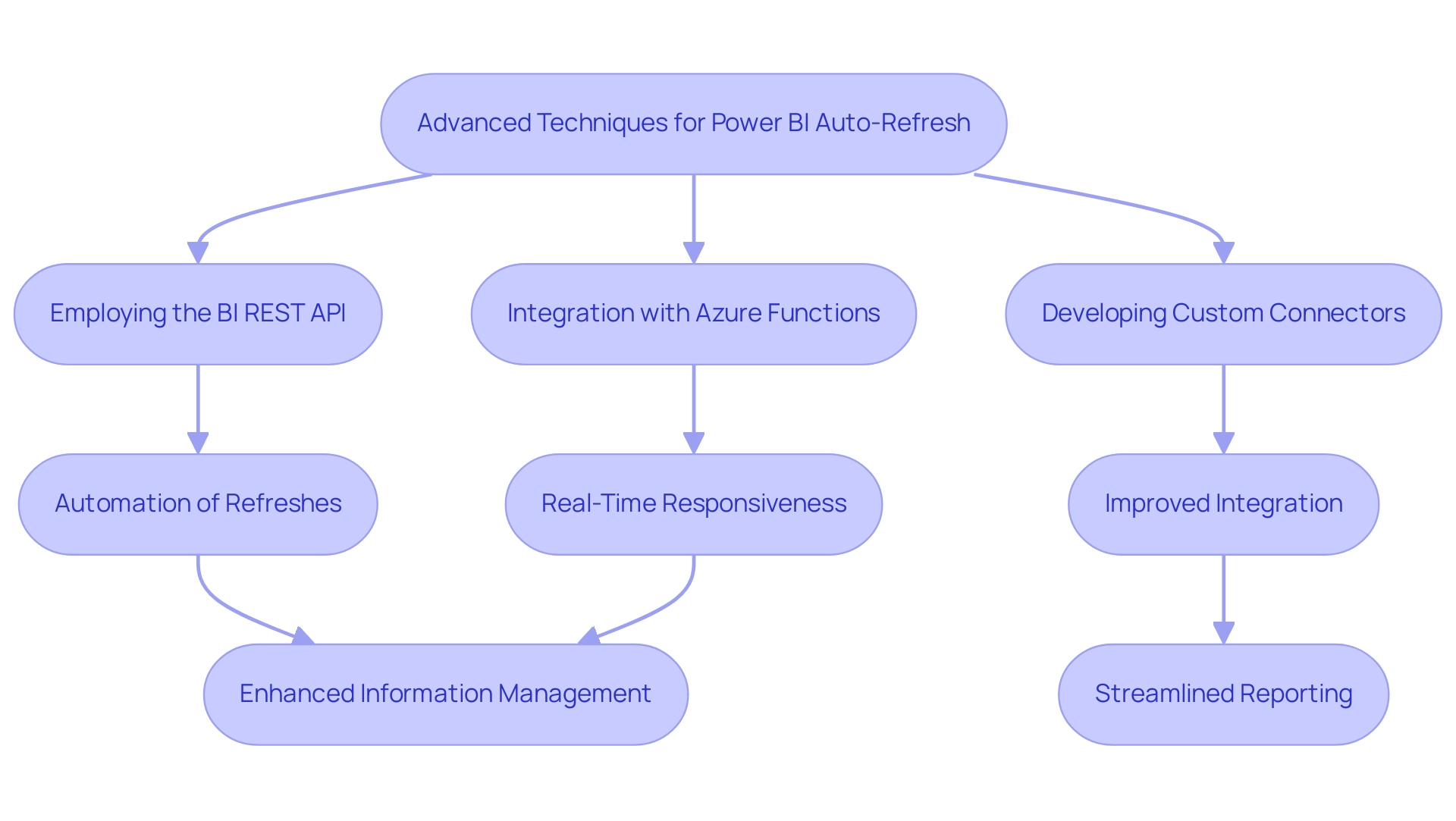
Conclusion
The integration of Power BI’s auto-refresh feature is a game-changer for organizations looking to enhance their decision-making processes. By automating data updates, businesses can ensure that their reports are not only current but also reflect the latest insights necessary for strategic planning. This capability, paired with tools like Power Automate and RPA, streamlines workflows and minimizes the time spent on manual updates, allowing teams to focus on more impactful initiatives.
Setting up auto-refresh is a straightforward process that can significantly improve reporting efficiency. Following a structured approach to configuration, monitoring refresh performance, and troubleshooting common issues ensures that organizations can leverage the full potential of their data. Best practices in publishing reports further enhance visibility and accessibility, driving collaboration across teams and facilitating informed decisions.
Moreover, advanced techniques such as utilizing the Power BI REST API and integrating with Azure Functions enable organizations to take their data management to the next level. By adopting these strategies, businesses can maintain a competitive edge in a data-rich environment, ensuring that they are equipped to adapt to rapid changes and capitalize on new opportunities. The journey towards maximizing operational efficiency through Power BI is not just about technology; it’s about empowering teams to harness data effectively for sustained growth and innovation.

